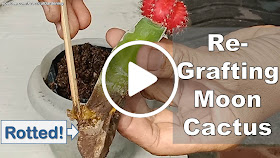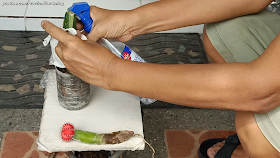Video Tutorial
Watch the video below to help you better understand the rest of the article.
How the Dragonfruit Plant Stock Can Be Damaged
In a previous article, I discussed the steps on how to graft the moon cactus to the a dragonfruit plant. These are moon cacti that were pups or offsets that I was able to harvest from my sister-in-law's potted mature moon cacti. Many of them thrived and fourished and even had pups of their own.
However, there will be mishaps along the way and this article will discuss what to do when the moon cactus dragonfruit stock is damaged or, in this case specifically, has rotted.
Sure, there may be other reasons like if the dragonfruit stem gets broken, or the moon cactus gets dislodged by some force, e.g., falling from a ledge to the ground. It could even be animals breaking or damaging the plant.
Sample of a Stock Damage (Rotted Stem)
The photo below shows a healthy-looking moon cactus that was grafted to a dragonfruit plant for its stock. The dragonfruit stem looked a bit droopy and has a pale color especially towards the base.
As I lifted the pot, the plant had a rubbery feel to it in that it seemed to bob or bounce as I lifted it up and set it on a table. It didn't look firm at all and was bending on one side.
Upon closer inspection, the discoloration was worse as I poked it at the base with a stick to clear the soil. The pale-green color on the stem instantly turned gray right under the soil.
Touching the stem had a loose feel and seemed that it wasn't firmly planted. The plant no longer had the healthy network of roots that would hold the soil. I was able to easily pull it out from the soil.
The primary root (long root) was still there as shown by the stick, but the secondary or side roots seem to have rotted away already.
Pulling out the plant showed an even darker-gray part at the base of the dragonfruit stem. This part was very soft and the stick could scratch it too easily. It looked rotted already.
As shown below, the stem is easily punctured by the stick. It is very mushy. The inside is yellow and brown. About half the length of the dragonfruit stem is rotted and the stem can no longer be saved.
The moon cactus, however, looks very much healthy. It has retained its near spherical shape. There is no hint of discoloration and actually has a vibrant shade.
It is firm and robust to the touch. This moon cactus can still be saved and will be re-grafted to a new and healthy dragonfruit plant stock.
If you're wondering how this dragonfruit stem may have rotted, it is this: overwatering. The grafted moon cactus is planted in a seedling bag. One day I decided to soak it in a soaking tub (white plastic container below) to water it. There was just enough water in the tub.
Steps to Re-Graft Moon Cactus with a Damaged or Rotted Stock
- The materials required to re-graft this moon cactus are: the salvageable healthy moon cactus, a new and healthy dragonfruit plant, a cutter or sharp knife, rubbing alcohol, rag or paper towels, a small plastic sheet and rubber bands.
-
Clean any cutting implements. Spray or apply rubbing alcohol on the blade of the cutter and wipe off with a rag or paper towels. Always do this with any cutting activity on plants.
You may also choose to wipe clean the new dragonfruit plant if it's been sitting for a while and has gathered dust or is soiled - just like this one.
Notice the new dragonfruit stock I have is taller. Also, I cut the ridges previously so the stem tapers towards the top.
- With a sharp cutter, cut off a big chunk of the rotted stem. Leave a little portion of it on the moon cactus for easier removal later.
- With the cutter, carefully pry off the still attached small portion of the dragonfruit stem on the moon cactus. The green stem can easily be removed in chucks or smaller pieces.
- There may be a part of the dragonfruit plant that remains inside the moon cactus and that is the pith. Remove the pith with the sharp pointed end of the knife or cutter.
- This is how the cleaned moon cactus will look like. Be sure to remove any excess debris.
- Take the new dragonfruit plant stock and make a fresh cut at the top. You'll need a fresh cut that will make contact with the cut moon cactus in the re-graft.
- Below, I'm rubbing the cut part of the dragnonfruit with the main stem. I'd also lift the the newly cut part away to see if it sticks and ensure that the sap isn't too watery.
In my observation, the stickier the sap is, the higher the probability that the graft will succeed. I'm checking for the stickiness of the sap without my fingers touching the cuts that may cause some contamination.
- Make a fresh cut at the bottom of the moon cactus. Try to make the cut as flat or level as possible for maximum contact with the new dragonfruit stock.
- Seat the moon cactus on top of the dragonfruit plant stock. Ensure that the full fleshy part of the bottom of the moon cactus is in contact with the center (or the pith area) of the dragonfruit stock.
Avoid positioning the hollowed-out part on the center of the stock. This is to ensure the pith of the dragonfruit plant makes contact with the moon cactus' fleshy part. The moon cactus doesn't have to be perfectly aligned and centered with the dragonfruit stock.
- Cover the moon cactus with a piece of plastic sheet that extends down towards the dragonfruit stock. The moon cactus should be completely covered.
- While applying downward pressure on the plastic sheet, pass a rubber band over the moon cactus and position at the dragonfruit stock. The pressure should just be enough to keep the moon cactus from shifting from its position.
The rubber band should be tight enough to continue pulling the plastic sheet downward. Doing this keeps the moon cactus firmly in its place on top of the dragonfruit stock.
- Put the newly re-grafted moon cactus in the shade but not dark. It should be shaded to protect it from the rains.
Ensure that it is not likely to be disturbed by wind or by pets and other animals. Avoid watering at this time. Keep it in this spot for about a week.
- After a week, take it out and inspect it for any signs of discoloration.
- Very carefully remove the rubber band that is securing the plastic sheet cover.
- Remove the plastic sheet cover
- Here, we see the re-grafted moon cactus still intact and doesn't fall off. There is no sign of discoloration or rotting with either the moon cactus scion or the dragonfruit stock.


























No comments:
Post a Comment